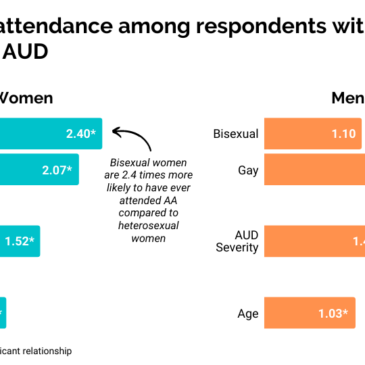Alcoholics Anonymous (AA) is the most widely available and used mutual-help program for individuals with alcohol use disorder (AUD) in the United States. AA is effective at addressing alcohol-related problems and AUD in the general population, performing as well or better than other treatment modalities, like cognitive behavioral therapy, on alcohol-related outcomes. However, little is known about whether people who identify as bisexual or gay/lesbian engage with AA to the same extent as heterosexuals. This week, as we approach Pride Month, the DRAM reviews a study by Briana L. McGeough and colleagues that examined rates and predictors of AA attendance across sexual orientations.
What were the research questions?
Do rates of AA attendance differ across sexual orientations? What are predictors of AA attendance across sexual orientations?
What did the researchers do?
The researchers pooled data from five waves of the nationally-representative National Alcohol Survey (1995-2015) conducted with U.S. adults every five years. The sample included 7,862 respondents who endorsed at least one lifetime symptom of AUD. Respondents reported their sexual orientation (heterosexual, bisexual, or gay/lesbian), demographic information, and whether they had ever gone to an AA meeting for their drinking (yes/no). Participants were assessed for lifetime AUD severity on a continuous scale from 0 to 11 based on the criteria for AUD.
The researchers conducted chi-square tests to examine the association between sexual orientation and AA attendance. They also fit multivariate logistic regression models to determine whether, controlling for other variables, sexual orientation was a factor in AA attendance. They fit separate models for men and women. The researchers also examined whether binary sexual orientation (heterosexual or sexual minority) and each variable interacted to predict AA attendance.
What did they find?
Overall, both gay/lesbian and bisexual respondents were more likely to have attended AA than their heterosexual counterparts. This finding held when controlling for demographic factors and lifetime AUD severity. When separated by gender, lesbian and bisexual women were more than twice as likely to have ever attended AA meetings compared to heterosexual women (see Figure). Among women, other factors associated with a higher likelihood of AA attendance included greater AUD severity, older age, and lower income. Black and Latinx race/ethnicity was associated with lower likelihood of AA attendance among women. Gay and bisexual men did not differ from heterosexual men in terms of AA attendance. However, greater AUD severity and older age were associated with a higher likelihood of AA attendance among men.
Older age and greater religiosity were associated with a higher likelihood of AA attendance for sexual minority women compared to heterosexual women. Sexual minority women with greater AUD severity were less likely to attend AA compared to their heterosexual counterparts.
Figure. Odds of AA attendance among respondents with 1+ lifetime symptom of AUD. Asterisks indicate a statistically significant relationship. The odds ratio for age is based on an age difference of one year. The odds ratio for AUD severity is based on a one point increase in the AUD severity scale. Click image to enlarge.
Why do these findings matter?
Sexual minority individuals are at higher risk for alcohol-related problems and AUD compared to their heterosexual counterparts. Findings from this study indicate that AA may serve as an appropriate resource for sexual minority individuals, particularly lesbian and bisexual women who are older, have less-severe AUD, and greater levels of religiosity. Other sexual minority men and women may also be well-served by AA, but may require additional supports. Providers should consider referring sexual minority clients struggling with their alcohol use to AA.
Every study has limitations. What are the limitations of this study?
This study only examined whether respondents ever attended an AA meeting. While sexual minorities may be more likely to initiate AA attendance, the findings cannot be used to determine continued engagement and involvement with AA over time. This study used binary gender classification and did not ask about gender identity, so results might not be applicable to non-binary and transgender individuals.
For more information:
The National Institute on Alcohol Abuse and Alcoholism offers tips and resources for people struggling with problem drinking. For additional drinking self-help tools, please visit the BASIS Addiction Resources page.
— Kira Landauer, MPH
What do you think? Please use the comment link below to provide feedback on this article.





